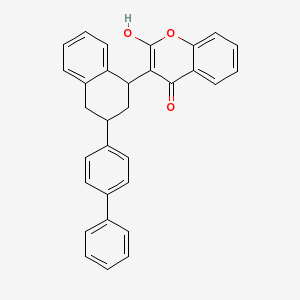| Nombre del producto |
Difenacoum |
| Nombre en inglés |
Difenacoum;Diphenacoum; Neosorexa; Ratak; 3-(3-biphenyl-4-yl-1,2,3,4-tetrahydro-1-naphthyl)-4-hydroxycoumarin; Difenakum; 3-(3-p-Diphenyl-1,2,3,4-tetrahydronaphth-1-yl) -4-hydroxycoumarin; COUMARIN, 3-(3-(4-BIPHENYLYL)-1,2,3,4-TETRAHYDRO-1-NAPHTHYL)-4-HYDROXY-; 3-(3-(1,1'-Biphenyl)-4-yl-1,2,3,4-tetrahydro-1-naphthalenyl)-4-hydroxy-2H-1-benzopyran-2-one; 2-hydroxy-3-[3-(4-phenylphenyl)-1,2,3,
4-tetrahydronaphthalen-1-yl]chromen-4-one; 3-[3-(biphenyl-4-yl)-1,2,3,4-tetrahydronaphthalen-1-yl]-2-hydroxy-4H-chromen-4-one; 3-[3-(biphenyl-4-yl)-1,2,3,4-tetrahydronaphthalen-1-yl]-4-hydroxy-2H-chromen-2-one |
| Fórmula molecular |
C31H24O3 |
| Peso Molecular |
444.5205 |
| InChI |
InChI=1/C31H24O3/c32-30-26-12-6-7-13-28(26)34-31(33)29(30)27-19-24(18-23-10-4-5-11-25(23)27)22-16-14-21(15-17-22)20-8-2-1-3-9-20/h1-17,24,27,32H,18-19H2 |
| Número de registro CAS |
56073-07-5 |
| EINECS |
259-978-4 |
| Estructura Molecular |

|
| Densidad |
1.272g/cm3 |
| Punto de ebullición |
647.94°C at 760 mmHg |
| Índice de refracción |
1.676 |
| Punto de inflamación |
257.538°C |
| Presión de vapor |
0mmHg at 25°C |
| Símbolos de Peligro |
 T+:Very toxic; T+:Very toxic;
 N:Dangerous for the Environment; N:Dangerous for the Environment;
|
| Códigos de Riesgos |
R28:Very toxic if swallowed.;
R48/25:Danger of serious damage to health by prolonged exposure and toxic if swallowed.;
R50/53:Very toxic to aquatic organisms, may cause long-term adverse effects in the aquatic environment.;
|
| Descripción de Seguridad |
S36/37:Wear suitable protective clothing and gloves. ;
S45:In case of accident or if you feel unwell, seek medical advice immediately (show the label whenever possible.) ;
S60:This material and its container must be disposed of as hazardous waste. ;
S61:Avoid release to the environment. Refer to special instructions / safety data sheets.;
|
|